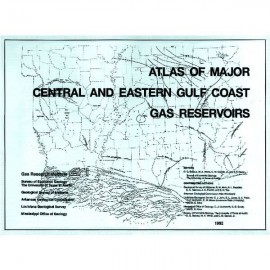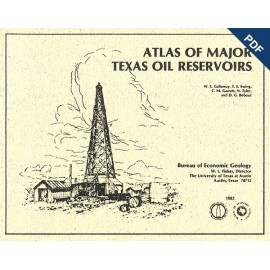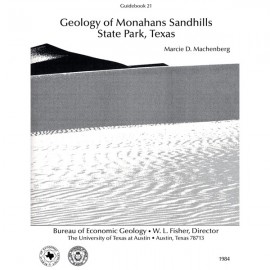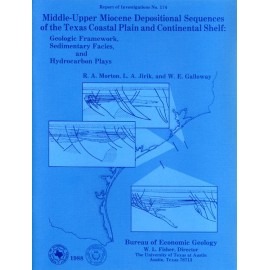Atlases of Major Oil and Gas Reservoirs
-
Books & Reports
- Reports of Investigations
- Guidebooks
- Udden Series
- Geological Circulars
- Down To Earth
- Atlases of Major Oil and Gas Reservoirs
- Texas Memorial Museum Publications
- Environmental Geologic Atlas of the Texas Coastal Zone
- Mineral Resource Circulars
- Other Reports
- Seminars and Workshops
- Handbooks
- Submerged Lands of Texas
- Symposia
- Annual Reports
- Open File Reports
-
Maps & Cross Sections
- Thematic Maps
- Miscellaneous Maps, Charts & Sections
- Geologic Atlas of Texas
- STATEMAP Project Maps
- Geologic Quadrangle Maps
- Cross Sections
- Highway Geology Map
- Energy and Mineral Resource Maps
- Shoreline Change and Other Posters
- Wilcox Group, East Texas, Geological / Hydrological Folios
- Bouguer Gravity Atlas of Texas
- River Basin Regional Studies
- Featured Maps
- Posters
- Teachers & the Public
-
Geological Society Publications
- Gulf Coast Association of Geological Societies
- Alabama Geological Society
- Austin Geological Society
- Corpus Christi Geological Society
- Houston Geological Society
- Lafayette Geological Society
- Mississippi Geological Society
- New Orleans Geological Society
- South Texas Geological Society
- GCS SEPM Publications
- Historic BEG & UT Series

Atlas of Major Texas Oil Reservoirs
AT0002
Atlas of Major Texas Oil Reservoirs, by W. E. Galloway, T. E. Ewing, C. M. Garrett, Noel Tyler, and D. G. Bebout. Oversize, coil-bound book, 139 p., 426 figs., 3 tables, 5 oversize color plates in back pocket, 1983. Print Version.
For a downloadable, digital version: AT0002D.
This product is no longer in stock
AT0002. Atlas of Major Texas Oil Reservoirs, by W. E. Galloway, T. E. Ewing, C. M. Garrett, Noel Tyler, and D. G. Bebout. Oversize, coil-bound book, 139 p., 426 figs., 3 tables, 5 oversize color plates in back pocket, 1983.
To purchase this publication as a PDF download, please order AT0002D.
To purchase this publication on CD-ROM, please order AT0002CD.
From the Introduction
Petroleum exploration in Texas has resulted in the discovery of 156 billion barrels of oil. Of this amount, ultimate recovery is estimated at 61 billion barrels. As a part of a broad research program, the Bureau of Economic Geology has compiled geologic, engineering, and volumetric data for nearly 450 of the most productive oil reservoirs in the state. In collecting and synthesizing data, we emphasized the individual reservoir, or, in the terminology of older literature, the pool.
Reservoirs described in this atlas each produced at least 10 million barrels of oil and have adequate data available for useful geologic description. A few recently discovered reservoirs that will rapidly exceed this production level are also included, as are a few reservoirs that will produce slightly less but are nonetheless interesting geologically. In addition, the first section describes productive features of piercement salt-dome fields, even though the complex structure of these fields precludes formation of large individual reservoirs.
The descriptive information, combined with an understanding of the geologic framework of the reservoirs, provides the basis for grouping individual reservoirs into larger families of pools called pIays. A “play” is an assemblage of geologically similar reservoirs exhibiting the same source, reservoir, and trap characteristics…Plays are delineated primarily according to the original depositional setting of the reservoirs or, less commonly, their relation to regional erosional surfaces or diagenetic facies.
…
The objectives of this atlas are twofold. First we define and describe, primarily by use of illustrations, the 48 oil plays identified by our survey and outline their regional settings and geologic characteristics. Second, we attempt to summarize, using available published and field record data, geologic, engineering, and volumetric parameters of the entire play and of each reservoir contained within the play. Few of the maps, figures, or interpretations are our own. Rather, we have attempted to edit or modify only as necessary for clarity or standardization of the figures. The reservoirs included in this atlas account for approximately 70 percent of recorded oil production in Texas through 1981 and thus constitute an excellent example of the petroleum geology of the state.
Keywords: oil, oil reservoirs, oil atlas, oil resources, plays, Texas
Citation
Galloway, W. E., Ewing, T. E., Garrett, C. M., Tyler, Noel, and Bebout, D. G., 1983, Atlas of Major Texas Oil Reservoirs: The University of Texas at Austin, Bureau of Economic Geology, Atlas of Major Texas Oil Reservoirs, 139 p.




